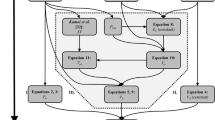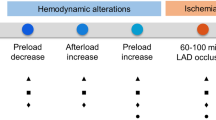Abstract
Experiments were performed to test the hypothesis that viscoelastic properties of the swine myocardium are independent of heart rate (HR), preload (PL), and afterload (AL). Left ventricular pressure and aortic flow (AoF) waveforms were recorded in 13 swine. At different paced heart rates, an inferior vena caval occlusion (IVC) was used to reduce PL, then the IVC was released and simultaneously the aorta was clamped to increase AL. Equivalent left ventricular pressure waveform pairs consisting of an ejecting waveform (denoted as LVP) and isovolumic waveform (denoted as hydromotive pressure, HMP) were selected according to specified criteria resulting in 371 equivalent waveform pairs. From the selected waveform pairs and corresponding aortic flow waveforms, the viscoelastic properties (k and ε1) were estimated by HMP = LVP + ε1 V EJ + k × LVP × AoF. Here ε1 is the parallel elastance, k is the myocardial friction, and V EJ is the integral of AoF over ejection. Next, using k, ε1, LVP, and AoF waveforms, HMP was estimated using the equation above. To validate the model, the measured HMP and model-calculated HMP were compared for 371 matched waveform pairs (R 2 = 0.97, SEE = 3.7 mmHg). The viscoelastic parameters (k and ε1) did not exhibit any clear or predictable dependence on HR, PL, and AL.
Similar content being viewed by others
REFERENCES
Berlew, B. S., and K. T. Weber. Connective tissue and the heart: Functional significance and regulatory mechanisms. Cardiol. Clin. 18(3):435–442, 2001.
Blix, M. Scand. Arch. Physiol. 4:399, 1893.
Burden, R. L., J. D. Faires, and A. C. Reynolds. Numerical differentiation In: Numerical Analysis, 2nd ed., edited by Weber and Schmidt. Boston: Prindle, 1981, p. 130.
Campbell, K. B., R. D. Kirkpatrick, G. G. Knowlen, and J. A. Ringo. Late-systolic pumping properties of the left-ventricledeviation from elastance-resistance behavior. Circ. Res. 66:218–233, 1990.
Chang, K. C., and T. S. Kuo. Single-beat estimation of the ventricular pumping mechanics in terms of the systolic elastance and resistance. J. Theor. Biol. 189:89–95, 1997.
Chapman, R. E., and F. G. Spinale. Extracellular protease activation and unraveling of the myocardial interstitium: Critical steps toward clinical applications. Am. J. Physiol. Heart Circ. Physiol. 286(1):H1–H10, 2004.
Covell, J. W., R. R. Taylor, E. H. Sonnenblick, and J. Ross, Jr. Series elasticity in the intact heart. Evidence for the application of the Hill model for muscle to the intact left ventricle. Pflugers Arch. 357(3-4):225–236, 1975.
Drew, G. A., and S. C. Koenig. Biomedical patient monitoring, data acquisition, and playback with LabVIEW. In: LabVIEW for Automotive, Telecommunication, Semiconductor, Biomedical, and Other Application. J. B. Olansen and E. Roscow (ed.) Upper Saddle River: Prentice-Hall PTR, 2000, pp. 92–98.
Elliot, G. F., and C. R. Worthington. Muscle contraction: Viscous friction and the impulsive model. Int. J. Biol.Macromol. 27:327–332, 2000.
Elzinga, G., and N. Westerhof. The pumping ability of the left heart and the effect of coronary occlusion. Circ. Res. 38(4):297–302, 1976.
Ernst, E. Sliding friction contra sliding hypothesis. Acta Biochim. Biophy. Acad. Sci. Hung. 12(1):83–85, 1977.
Fenn, W. O. A quantitative comparison between the energy liberated and the work performed by the isolated sartorius muscle of the frog. J. Physiol. 58:175–203, 1923.
Ficke, A. 1882.Mech. ArbeitK.Wärmeentwickelung b.d. muskel thätigkeit, Leipzig: Brockhaus, p 67.
Fung, Y. C. Mathematical representation of the mechanical properties of the heart muscle. J. Biomech. 3(4):381–404, 1970.
Fung, Y. C. Comparison of different models of the heart muscle. J. Biomech. 4(4):289–295, 1971.
Glantz, S. A. A constitutive equation for the passive properties of muscle. J. Biomech. 7(2):137–145, 1974.
Glantz, S. A. A three-element model describes excised cat papillary muscle elasticity. Am. J. Physiol. 228(1):284–294, 1975.
Goldsmith, E. C., and T. K. Borg. The dynamic interaction of the extracellular matrix in cardiac remodeling. J. Card. Fail. 8(6, Suppl.):S314–S318, 2002.
Granzier, H. L., and S. Labeit. The giant protein titin: A major player in myocardial mechanics, signaling, and disease. Circ. Res. 94(3):284–295, 2004.
Harris, T.S., C. F. Baicu, C. H. Conrad, M. Koide, J.M. Buckley, M. Barnes, G. Cooper IV, and M. R. Zile. Constitutive properties of hypertrophied myocardium: Cellular contribution to changes in myocardial stiffness. Am. J. Physiol. Heart Circ. Physiol. 282:H2173–H2182, 2002.
Hein, S., S. Kostin, A. Heling, Y. Maeno, and J. Schaper. The role of the cytoskeleton in heart failure. Cardiovasc. Res. 45:273–278, 2000.
Hein, S., D. Scholz, N. Fujitani, H. Rennollet, T. Brand, A. Friedl, and J. Schaper. Altered expression of titin and contractile proteins in failing human myocardium. J. Mol. Cell. Cardiol. 26:1291–1306, 1994.
Hess, O. M., J. Grimm, and H. P. Krayenbuehl. Diastolic simple elastic and viscoelastic properties of the left ventricle in man. Circulation 59(6):1178–1187, 1979.
Hill, A. The maximum work and mechanical efficiency of human muscles, and their most economical speed. J. Physiol. 56:19–41, 1922.
Hill, A. Myothermic Experiments on the frog's gastrocnemius. Proc. R. Soc. Ser. B 109:267–303, 1931.
Hill, A. V. The heat of shortening and the dynamic constants of muscle. Proc. R. Soc. Ser. B 126:136–195, 1938.
Hunter, P. J., A. D. McCulloch, and H. E. D. J. ter Keurs. Modelling the mechanical properties of cardiac muscle. Prog. Biophys. Mol. Biol. 69(2-3):289–331, 1998. Review.
Hunter, W. C., J. S. Janicki, and K. T. Weber. Mechanical properties of the ventricle during systole. Fed. Proc. 39:169–174, 1980.
Hunter, W. C., J. S. Janicki, K. T. Weber, and A. Noordergraaf. Flow-pulse response: New method for the characterization of ventricular mechanics. Am. J. Physiol. Heart Circ. Physiol. 237:H282–H292, 1979.
Hunter, W. C., J. S. Janicki, K. T. Weber, and A. Noordergraaf. Systolic mechanical properties of the left ventricle: Effects of volume and contractile state. Circ. Res. 52:319–327, 1983.
Huxley, A. F. Muscle structure and theories of contraction. Prog. Biophys. Biophys. Chem. 7:255–318, 1957.
Huxley, A. F., and R. Niedergerke. Structural changes in muscle during contraction; interference microscopy of living muscle fibres. Nature 173:971–973, 1954.
Huxley, H. E., and E. J. Hanson. Changes in the cross-striations of muscle during contraction and stretch and their structural interpretation. Nature 173:973–976, 1954.
Kulke, M., S. Fukita-Becker, E. Rostkova, C. Neagoe, K. Labeit, D. J. Manstein, M. Gautel, and W. A. Linke. Interaction between PEVK-Titan and actine filament: Origin of a viscous force component in cardiac myofibrils. Circ. Res. 89:874–881, 2001.
Landesberg, A., Y. Landesberg, S. Sideman, and H. E. Ter Kers. Molecular motion and cardiac muscle motor dynamics. Ann. N. Y. Acad. Sci. 972:119–126, 2002.
Landesberg, A., L. Livshitz, and H. E. ter Keurs. The effect of sarcomere shortening velocity on force generation, analysis, and verification of models for crossbridge dynamics. Ann. Biomed. Eng. 28(8):968–978, 2000.
Linke, W. A., and J. M. Fernandez. Cardiac titan: Molecular basis of elasticity and cellular contribution to elastic and viscous stiffness components in myocardium. J. Muscle Res. Cell Motil. 23:483–497, 2002.
Morano, I., K. Hadicke, S. Grom, A. Koch, R. H. Schwinger, M. Bohm, S. Bartel, E. Erdmann, and E. G. Krause. Titin, myosin light chains and C-protein in the developing and failing human heart. J. Mol. Cell Cardiol. 26:361–368, 1994.
Palladino, J. L., and A. Noordergraaf. Muscle contraction mechanics from ultrastructural dynamics. In: Analysis and Assessment of Cardiovascular Function, edited by G. Drzewiecki and J. K. J. Li. New York: Springer-Verlag, 1998, pp. 33–57.
Piene, H. Impedance matching between ventricle and load. Ann. Biomed. Eng. 12(2):191–207, 1984.
Rankin, J. S., C. E. Arentzen, P. A. McHale, D. Ling, and R.W. Anderson. Viscoelastic properties of the diastolic left ventricle in the conscious dog. Circ. Res. 41(1):37–45, 1977.
Regen, D. M., P. Denton, W. Howe, L. Taylor, and D. Hansen. Characteristics of left-ventricular isovolumic pressure waves in isolated dog hearts. Heart Vessels 9:155–166, 1994.
Schroeder, M. J., B. Perrault, D. L. Ewert, and S. C. Koenig. HEART: An automated beat-to-beat cardiovascular analysis package using Matlab. Comp. Biol. Med. 34:371–388, 2003.
Schroff, S. G., J. S. Janicki, and K. T. Weber. Evidence and quantitation of left ventricular systolic resistance. Am. J. Physiol. Heart Circ. Physiol. 249:H358–H370, 1985.
Sonneblick, E. H. Implications of muscle mechanics in the heart. Fed. Proc. 21:975–990, 1962.
Sonneblick, E. H. Force velocity relations in mammalian muscle. Am. J. Physiol. 202:932–939, 1962.
F. G. Spinale, and M. R. Zile. Viscoelastic properties of pressure overload hypertrophied myocardium: Effect of serine protease treatment. Am. J. Physiol. Heart Circ. Physiol. 282:H2324–H2335, 2002.
Suga, H. Time course of left ventricular pressure-volume relationship under various end-diastolic volumes. Japan Heart J. 10:509–515, 1969.
Suga, H. Time course of left ventricular pressure-volume relationship under various extents of aortic occlusion. Japan Heart J. 11:373–378, 1970.
Suga, H. Left ventricular time-varying pressure-volume ratio in systole as index of myocardial inotropism. Japan Heart J. 12:153–160, 1971.
Sunagawa, K., A. Yamad, Y. Senda, Y. Kikuchi, M. Nakamura, T. Shibahara, and Y.Nose. Estimation of the hydromotive source pressure from ejecting beats of the left ventricle. IEEE Trans. Biomed. Eng. 27:299–305, 1980.
Takeda, K., R. Kadot, S. Yagi. Time-varying myocardial elastance of canine left ventricle. Am. J. Physiol. Heart Circ. Physiol. 261:H1554–H1562, 1991.
Takeuchi, M., Y. Igarashi, S. Tomimoto, M. Odake, T. Hayashi, T. Tsukamoto, K. Hata, H. Takaoka, and H. Fukuzaki. Singlebeat estimation of the slope of the end-systolic pressure-volume relation in the human left ventricle. Circ. 83:202–212, 1991.
Thevenin, M. L. Rendus hebdomadaires de seances de L'Academie des sciences, XCVII, 159, 1883.
Tskhovrebova, L., and J. Trinick. Role of titan in vertebrate striated muscle. Philos. Trans. R. Soc. Lond. B Biol. Sci. 357:199–206, 2002.
Wang, X., F. Li, S. E. Campbell, and A. M. Gerdes. Chronic pressure overload cardiac hypertrophy and failure in guinea pigs: II. Cytoskeletal remodeling. J. Mol. Cell Cardiol. 31(2):319–331, 1999.
Yamamoto, S., H. Tsutsui, M. Takahashi, Y. Ishibashi, H. Tagawa, K. Imanaka-Yoshida, Y. Saeki, and A. Takeshita. Role of microtubules in the viscoelastic properties of isolated cardiac muscle. J. Mol. Cell Cardiol. 30(9):1841–1853,1998.
Author information
Authors and Affiliations
Corresponding author
Rights and permissions
About this article
Cite this article
Ewert, D., Wheeler, B., Doetkott, C. et al. The Effect of Heart Rate, Preload, and Afterload on the Viscoelastic Properties of the Swine Myocardium. Annals of Biomedical Engineering 32, 1211–1222 (2004). https://doi.org/10.1114/B:ABME.0000039355.53117.6f
Issue Date:
DOI: https://doi.org/10.1114/B:ABME.0000039355.53117.6f




